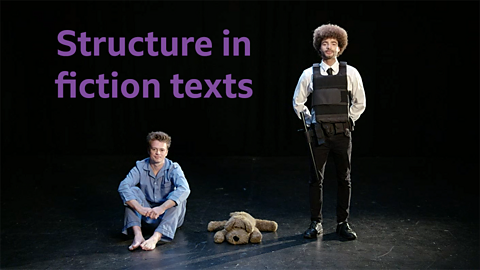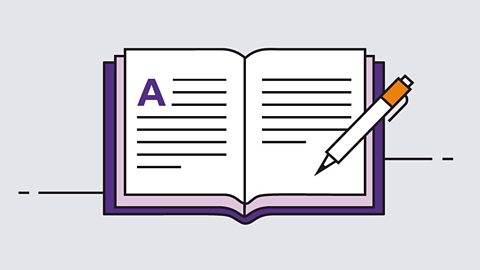Introduction to investigating language in fiction texts
- A writer may use a variety of language techniques to create mood and tone.
- Figurative language and symbolism can be used to create an effect on a reader.
- Similes and metaphors are a powerful way to suggest ideas.
Learn how word choice, perspective and symbolism can affect the reader

When looking at language in fiction texts it is important to start by reading the extract carefully:
- what is happening?
- who is involved?
- how does it make you feel as you read?
- what word choices has the writer made, and what affect may they have on a reader?
Figurative language is when words or expressions are used to suggest a meaning that is different from the literal interpretation. If the weather is bad, instead of saying ‘the weather is bad’ someone might use figurative language and say ‘it’s raining cats and dogs’ - nobody would expect real animals to be falling from the sky but the reader understands that the raindrops are very heavy!
There are lots of figurative language techniques that a writer might use to create an effect on the reader. Some of the most commonly used are similes and metaphors.
A simile is a comparison between two items where the writer uses the words ‘like’ or ‘as’ - for example, ‘hands as cold as ice’. Similes can be exaggerated - the hands might not have the exact temperature of ice, but the writer is suggesting that they are surprisingly cold.
A metaphor is when a word or phrase is applied to an object or action to which it is not literally applicable, for example, ‘his heart is ice’. While this isn't literally true, the writer states this outright for impact.

Analyse character through language
In this extract from Martin Pyg by Kevin Brooks, Martin describes his aunt using similes, symbolism and figurative language. What impression of her do we get from his language choices?
Click on each word and see if you agree.
An angularPointy, sharp woman, cold and hardunfriendly, unpleasant, not welcoming, with crispy blue hairSeems unnatural and a face that makes you shudderHorrible or terrifying. I don’t know what colour her eyes areSounds like he is too afraid to look her in the eyedon’t know what colour her eyes areSounds like he is too afraid to look her in the eye, but they look as if they never closeShe is always watching – unnatural, creepy, can’t get away from her. They have about as much warmth as two depthless poolsDead-eyed, unfriendly. ‘Depthless pools’ sound dark/deep/dangerous, could swallow you and drown you Her mouth is thinNot soft or full. and pillar-box redRed is a colour of danger – blood, warning signs, traffic lights, like something drawn by a disturbed childUpsetting – she is like a nightmare. And she walks faster than most people run. ...like a huntress, quick and quiet...She is out to get you – threatening, dangerous, a predator and we are her prey...like a huntress, quick and quiet...She is out to get you – threatening, dangerous, a predator and we are her prey...like a huntress, quick and quiet...She is out to get you – threatening, dangerous, a predator and we are her prey I used to have nightmares about her. I still do.
Exploring figurative language
Metaphors and similes work through comparison and therefore can be a powerful way to suggest ideas or characteristics, and evoke associations.
Look at the following example from Fire Colour One by Jenny Valentine. Here, the main character, Iris, describes lighting a fire:
I struck a match. It made my heartbeat pop like a hit of strong caffeine, like an adrenaline shot. I put the flame to a clutch of dead and tangled grass, dropped it on a nest of papers. It flickered and spread. I crossed cuttings and small branches like a lattice across the top of the bowl, like the bars of a cage, and the fire ate through them, hungry as hell.
The narrator compares the effect striking a match has on her heartbeat to ‘a hit of strong caffeine’ and ‘an adrenaline shot’. Both similes imply a sudden impact, but perhaps a desirable one. These are both things that might be necessary. The idea of force is also emphasised by the nouns ‘hit’ and ‘shot’, which we might associate with violent acts.
The fire ‘eats’ through the branches as though it is alive, dangerous and unstoppable. This is an example of personification - a form of metaphor where a non-human object is given human characteristics. Notice that the fire is ‘hungry’, again suggesting that it is alive.
More types of metaphor
An extended metaphor is where the idea created through a metaphor is developed over several sentences, paragraphs or even throughout the text. It allows the writer to make a more sustained comparison. Notice how the metaphor of a blanket is ‘extended’ over several sentences here:
‘Darkness is a thick, black blanket, covering the world. It smothers the earth, soft and enveloping. Actions are hidden in its cosy embrace.’
Pathetic fallacy is a form of metaphor that is similar to personification and is usually applied to the natural world - trees, weather, seasons, etc. A writer may use extreme weather to represent the mood or tone of that passage of writing.
In Frankenstein by Mary Shelley, for example, the Doctor tells the reader, ‘It was a dreary night in November … the rain pattered dismally against the panes’. The adverb ‘dismally’ could suggest that the rain itself has feelings, a form of personification, Shelley may also be reflecting on the narrator’s mood at this point in the novel. An ominous atmosphere is created.
Remember
A writer's language choices will help create a sense of mood and tone. Meaning may also be influenced by different language techniques.
How much do you know about language in fiction quiz!
Where next?
Discover more from around Bitesize.
How to use language for effect. revision-guideHow to use language for effect
KS3 English with media

More on Critical reading
Find out more by working through a topic
- count3 of 4

- count4 of 4


